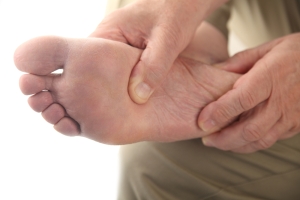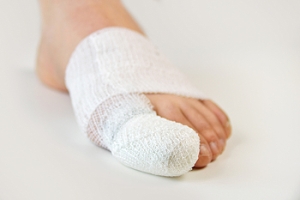
Why Live with Pain and Numbness in Your Feet?
Causes and Symptoms of Cuboid Syndrome
 Cuboid syndrome can occur when the cuboid bone, located at the center of the foot, dislocates. While cuboid syndrome is common in athletes and dancers, there are many common causes of this ailment, and it can affect anyone. Situations such as overuse, ankle sprains, pronated or inward-turned feet, sports with side to side movement, training on uneven surfaces, or poorly fitted shoes can all lead to the cuboid bone becoming dislodged. Some symptoms of cuboid syndrome may include a sharp pain on the side of the little toe, difficulty walking, worsening pain when pushing off, and a reduced range of motion in the foot. If you believe that you are experiencing cuboid syndrome, it is important to consult with a podiatrist for proper treatment and care.
Cuboid syndrome can occur when the cuboid bone, located at the center of the foot, dislocates. While cuboid syndrome is common in athletes and dancers, there are many common causes of this ailment, and it can affect anyone. Situations such as overuse, ankle sprains, pronated or inward-turned feet, sports with side to side movement, training on uneven surfaces, or poorly fitted shoes can all lead to the cuboid bone becoming dislodged. Some symptoms of cuboid syndrome may include a sharp pain on the side of the little toe, difficulty walking, worsening pain when pushing off, and a reduced range of motion in the foot. If you believe that you are experiencing cuboid syndrome, it is important to consult with a podiatrist for proper treatment and care.
Cuboid syndrome, also known as cuboid subluxation, occurs when the joints and ligaments near the cuboid bone in the foot become torn. If you have cuboid syndrome, consult with one of our podiatrists from William Street Podiatry. Our doctors will assess your condition and provide you with quality foot and ankle treatment.
Cuboid syndrome is a common cause of lateral foot pain, which is pain on the outside of the foot. The condition may happen suddenly due to an ankle sprain, or it may develop slowly overtime from repetitive tension through the bone and surrounding structures.
Causes
The most common causes of cuboid syndrome include:
- Injury – The most common cause of this ailment is an ankle sprain.
- Repetitive Strain – Tension placed through the peroneus longus muscle from repetitive activities such as jumping and running may cause excessive traction on the bone causing it to sublux.
- Altered Foot Biomechanics – Most people suffering from cuboid subluxation have flat feet.
Symptoms
A common symptom of cuboid syndrome is pain along the outside of the foot which can be felt in the ankle and toes. This pain may create walking difficulties and may cause those with the condition to walk with a limp.
Diagnosis
Diagnosis of cuboid syndrome is often difficult, and it is often misdiagnosed. X-rays, MRIs and CT scans often fail to properly show the cuboid subluxation. Although there isn’t a specific test used to diagnose cuboid syndrome, your podiatrist will usually check if pain is felt while pressing firmly on the cuboid bone of your foot.
Treatment
Just as the range of causes varies widely, so do treatments. Some more common treatments are ice therapy, rest, exercise, taping, and orthotics.
If you have any questions, please feel free to contact one of our offices located in William Street in New York, NY, Forest Hills, NY, and Broadway in New York, NY . We offer the newest diagnostic and treatment technologies for all your foot care needs.
Cuboid Syndrome
Cuboid syndrome mostly affects athletes, although it can affect non-athletes too. It is also known as cuboid subluxation or cuboid fault syndrome. This condition occurs when joints and ligaments near the cuboid bone of the foot are damaged, or when the cuboid bone itself is dislodged from its natural position. It is usually marked by pain on the outer side of the foot, which may be persistent or may come and go. Cuboid syndrome can be difficult to diagnose unless it becomes severe and more noticeable. Your doctor will likely ask questions about when the pain began and how long it has been present, and will put pressure on the cuboid bone to determine if that area is the origin of the pain.
Causes of Cuboid Syndrome
- Any repetitive stresses placed on the foot due to athletic activities are a common cause of cuboid syndrome.
- Although it develops over time, it is possible that this syndrome can occur all of sudden due to a single event or injury.
- Over-pronation can exacerbate the condition if not corrected.
Disagreements Amongst Podiatrists Regarding Cuboid Syndrome
- Some refer to it as the dislocation of the calcaneal-cuboid joint only.
- Other podiatrists see it as an injury of the ligaments located nearby, which also involves the cuboid bone.
It is very important that when you experience any kind of pain on the side of your foot, you should seek medical care right away. If a subluxed cuboid is caught early, your feet may respond well to the treatment, and you can get back into sports or other activities again as soon as the pain subsides.
How a Podiatrist Can Help with Diabetes
 Podiatrists play an important role in helping people with diabetes maintain healthy feet. A podiatrist can perform vascular testing to determine if you have reduced blood flow to your feet and can diagnose peripheral neuropathy, a common cause of lower limb weakness, numbness, and pain. A common symptom of diabetes are ulcers on the feet. A podiatrist can provide care for ulcers and prevent new ones from developing. As people with diabetes face an increased risk of limb amputation, it is important to see a podiatrist for monitoring, routine care, and prevention. If you have diabetes and experience pain or other symptoms in your legs and feet, don’t hesitate to consult a podiatrist.
Podiatrists play an important role in helping people with diabetes maintain healthy feet. A podiatrist can perform vascular testing to determine if you have reduced blood flow to your feet and can diagnose peripheral neuropathy, a common cause of lower limb weakness, numbness, and pain. A common symptom of diabetes are ulcers on the feet. A podiatrist can provide care for ulcers and prevent new ones from developing. As people with diabetes face an increased risk of limb amputation, it is important to see a podiatrist for monitoring, routine care, and prevention. If you have diabetes and experience pain or other symptoms in your legs and feet, don’t hesitate to consult a podiatrist.
Limb salvage can be an effective way in preventing the need for limb amputation. If you have diabetes, cancer, or any other condition that could lead to foot amputation if left unchecked, consult with one of our podiatrists from William Street Podiatry. Our doctors will assess your condition and provide you with quality foot and ankle treatment.
What Is Limb Salvage?
Limb salvage is the attempt of saving a limb, such as the foot from amputation. Podiatrists also try to make sure that there is enough function in the foot after the salvage that it is still usable. Diabetes is the number one cause of non-traumatic amputations in the United States. Those with diabetes experience poor blood circulation, which prevents proper healing of an ulcer. If the ulcer is left uncheck, it could become infected, which could result in the need for amputation.
However, there are other causes as well, such as cancer and traumatic injury. Links between higher mortality rates and amputation have been found. This translates into higher healthcare costs, and a reduced quality of life and mobility for amputees. Podiatrists have attempted to increase the prevalence of limb salvage in an attempt to solve these issues.
Diagnosis and Treatment
Limb salvage teams have grown in recent years that utilize a number of different treatments to save the infected limb. This includes podiatrists that specialize in wound care, rehabilitation, orthotics, and surgery. Through a combination of these methods, limb salvage has been found to be an effective treatment for infected limbs, and as an alternative to amputation. Podiatrists will first evaluate the potential for limb salvage and determine if the limb can be saved or must be amputated.
If you have any questions, please feel free to contact one of our offices located in William Street in New York, NY, Forest Hills, NY, and Broadway in New York, NY . We offer the newest diagnostic and treatment technologies for all your foot care needs.
Limb Salvage
Limb salvage is a procedure that involves saving a lower extremity from amputation. In podiatry, limb amputation often occurs as a result of diabetes, peripheral vascular disease, neuropathy, cancer, and severe crush injury. The fundamental goal of limb salvage is to restore and maintain stability and movement of the affected lower extremity.
The procedure typically involves removing the diseased tissue and a small portion of the surrounding healthy tissue, as well as the removal of any affected bone if necessary. If the bone is removed, it is then replaced with prostheses, synthetic metal rods or plates, or grafts from either the patient’s body or a donor. Limb salvage is typically the preferred choice of procedure over amputation, as the procedure preserves both the patient’s appearance and allows for the greatest possible degree of function in the affected limb.
Upon diagnosis and determining that limb salvage is the appropriate treatment, the podiatrist may enlist the help of a physical and/or occupational therapist to prepare the patient for surgery by introducing various muscle-strengthening, walking, and range of motion exercises. Such exercises may be continued as rehabilitation post-procedure.
What Causes Ankle Pain?
 The hinge joints that are located in the ankle allow for maximum mobility and range of motion. They are necessary in supporting the weight of the body, and provide the ability to walk, run, and jump. Inflammation and swelling often accompanies an ankle injury, and it may be difficult to move the affected foot. Additional symptoms can include muscle soreness, a tingling sensation, and the ankle may feel unstable. Ankle pain can occur for a variety of reasons. These can include structural deformities, Achilles tendon injuries, or from existing medical conditions consisting of lupus and different types of arthritis. If you are experiencing any type of ankle pain, it is strongly advised that you speak with a podiatrist who can help you to manage this condition.
The hinge joints that are located in the ankle allow for maximum mobility and range of motion. They are necessary in supporting the weight of the body, and provide the ability to walk, run, and jump. Inflammation and swelling often accompanies an ankle injury, and it may be difficult to move the affected foot. Additional symptoms can include muscle soreness, a tingling sensation, and the ankle may feel unstable. Ankle pain can occur for a variety of reasons. These can include structural deformities, Achilles tendon injuries, or from existing medical conditions consisting of lupus and different types of arthritis. If you are experiencing any type of ankle pain, it is strongly advised that you speak with a podiatrist who can help you to manage this condition.
Ankle pain can have many different causes and the pain may potentially be serious. If you have ankle pain, consult with one of our podiatrists from William Street Podiatry. Our doctors will assess your condition and provide you with quality foot and ankle treatment.
Ankle pain is any condition that causes pain in the ankle. Due to the fact that the ankle consists of tendons, muscles, bones, and ligaments, ankle pain can come from a number of different conditions.
Causes
The most common causes of ankle pain include:
- Types of arthritis (rheumatoid, osteoarthritis, and gout)
- Ankle sprains
- Broken ankles
- Achilles tendinitis
- Achilles tendon rupture
- Stress fractures
- Tarsal tunnel syndrome
- Plantar fasciitis
Symptoms
Symptoms of ankle injury vary based upon the condition. Pain may include general pain and discomfort, swelling, aching, redness, bruising, burning or stabbing sensations, and/or loss of sensation.
Diagnosis
Due to the wide variety of potential causes of ankle pain, podiatrists will utilize a number of different methods to properly diagnose ankle pain. This can include asking for personal and family medical histories and of any recent injuries. Further diagnosis may include sensation tests, a physical examination, and potentially x-rays or other imaging tests.
Treatment
Just as the range of causes varies widely, so do treatments. Some more common treatments are rest, ice packs, keeping pressure off the foot, orthotics and braces, medication for inflammation and pain, and surgery.
If you have any questions, please feel free to contact one of our offices located in William Street in New York, NY, Forest Hills, NY, and Broadway in New York, NY . We offer the newest diagnostic and treatment technologies for all your foot care needs.
Ankle Pain
The ankle joint is the point at which the bones of the leg and foot join. This joint is crucial because it is responsible for the foot’s mobility. Ankle pain is typically the result of inflammation from an injury to bones, joint space, cartilage, ligaments, tendons, or muscles in the area. Commonly associated symptoms with ankle pain are bruising, redness, numbness, stiffness, weakness, and tingling.
The most common causes of ankle pain are sprains and injuries. Ankle sprains are one of the most common musculoskeletal injuries. Sprains occur when the ligaments of the ankle become partially or completely torn due to sudden stretching. Sprains can occur on either the inner or outer sides of the ankle joint. Usually, these injuries occur when the ankle is twisted in an activity by stepping off an uneven surface. More specific causes include rheumatoid arthritis, gout, osteoarthritis, and Achilles tendonitis.
If you are experiencing ankle pain, you should consult with your podiatrist to choose the best method of care. Your doctor will conduct an examination of your ankle to determine the underlying cause of the pain.
Boating and Broken Toes
 There are many people who enjoy the sport of boating. If a broken toe occurs, it may go unattended in the midst of the many duties that are performed onboard. Common causes of broken toes consist of stubbing the toe against a piece of furniture, or from dropping a heavy object on it. Noticeable symptoms of a mild fracture may appear within the first 24 hours, whereas a severe break will show almost immediately, so it is important to begin an effective treatment method. Some of the signs of a broken toe can include pain, swelling, and it may be difficult to walk. Mild relief can be found when the affected foot is elevated. Many patients choose to tape the toe to the toe next to it, and this is referred to as buddy taping. This can be helpful in providing stability as the healing process begins. If you have broken your toe, it is suggested that you consult with a podiatrist who can properly diagnose and treat broken toes.
There are many people who enjoy the sport of boating. If a broken toe occurs, it may go unattended in the midst of the many duties that are performed onboard. Common causes of broken toes consist of stubbing the toe against a piece of furniture, or from dropping a heavy object on it. Noticeable symptoms of a mild fracture may appear within the first 24 hours, whereas a severe break will show almost immediately, so it is important to begin an effective treatment method. Some of the signs of a broken toe can include pain, swelling, and it may be difficult to walk. Mild relief can be found when the affected foot is elevated. Many patients choose to tape the toe to the toe next to it, and this is referred to as buddy taping. This can be helpful in providing stability as the healing process begins. If you have broken your toe, it is suggested that you consult with a podiatrist who can properly diagnose and treat broken toes.
A broken toe can be very painful and lead to complications if not properly fixed. If you have any concerns about your feet, contact one of our podiatrists from William Street Podiatry. Our doctors will treat your foot and ankle needs.
What to Know About a Broken Toe
Although most people try to avoid foot trauma such as banging, stubbing, or dropping heavy objects on their feet, the unfortunate fact is that it is a common occurrence. Given the fact that toes are positioned in front of the feet, they typically sustain the brunt of such trauma. When trauma occurs to a toe, the result can be a painful break (fracture).
Symptoms of a Broken Toe
- Throbbing pain
- Swelling
- Bruising on the skin and toenail
- The inability to move the toe
- Toe appears crooked or disfigured
- Tingling or numbness in the toe
Generally, it is best to stay off of the injured toe with the affected foot elevated.
Severe toe fractures may be treated with a splint, cast, and in some cases, minor surgery. Due to its position and the pressure it endures with daily activity, future complications can occur if the big toe is not properly treated.
If you have any questions please feel free to contact one of our offices located in William Street in New York, NY, Forest Hills, NY, and Broadway in New York, NY . We offer the newest diagnostic and treatment technologies for all your foot and ankle needs.
What to Know About a Broken Toe
The forefoot is composed of five metatarsal bones and fourteen phalanges. Each toe has three phalanges except for the big toe which only has two. Our toes play an essential role to the walking process, which is why a broken toe could seriously disrupt one’s ability to move around. Toe fractures are common and can be very painful. Fortunately, these injuries rarely require surgery and usually heal with rest and a change in activity.
Broken toes typically result from a traumatic event such as falling, stubbing the toe, or dropping something on the toe. Traumatic toe fractures may be categorized as either minor or severe fractures. At times, one may hear a “pop” or “crack” sound when the bone breaks. Common symptoms of a traumatic toe fracture include pain, throbbing, bruising, swelling, and redness.
Another type of toe fractures is a stress fracture. These injuries usually appear in the form of small hairline breaks on the bone. Stress fractures develop after repetitive activity instead of a single injury. Stress fractures occur when the muscles in the bone become too weak to absorb impact. Consequently, the toe bone becomes vulnerable to any pressure and impact it endures. Symptoms for a stress fracture in the toe include swelling without bruising, tenderness to the touch, pain that goes away with rest, and pain after walking or running.
If you suspect that you have a broken toe, you should make an appointment with your podiatrist. He or she will likely diagnose you by performing a physical exam and an X-ray. Treatment for a broken toe may include the R.I.C.E. method, buddy taping, surgery, or antibiotics. The R.I.C.E. method (Rest, Ice, Compression, and Elevation) is a common treatment method for many injuries because it decreases pain. Buddy tapping involves wrapping the injured toe next to an adjacent toe to keep it supported and protected. These two methods have proven to be effective in the healing process for toe fractures. The estimated healing time for a broken toe is approximately four to six weeks. If the injury becomes infected or requires surgery, the estimated healing time may take eight weeks or more.









